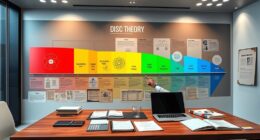As a fresher, you'll likely encounter key interview questions that test your readiness. Start with a self-introduction that highlights your background and relevant education. Be prepared to discuss your strengths and weaknesses—providing examples helps. Employers often ask about your career goals, so align them with the company's mission. You'll need to demonstrate teamwork experience, conflict resolution skills, and how you handle stress. Finally, always have insightful questions for the interviewer to show your interest. Mastering these areas can set you apart, and you might discover even more insights ahead.
Key Takeaways
- Be prepared to introduce yourself by sharing your background, education, and relevant experiences in a concise manner.
- Highlight your strengths with specific examples that demonstrate how you can contribute to the role or organization.
- Acknowledge a genuine weakness and discuss the steps you've taken to improve it, showcasing self-awareness and growth.
- Share your career goals and how they align with the company's objectives, emphasizing your desire for leadership and impactful contributions.
- Describe a past teamwork experience using the STAR method, focusing on your role, communication strategies, and how challenges were overcome collaboratively.
Self-Introduction

A strong self-introduction sets the tone for your interview, so it's crucial to make a good impression.
Begin by briefly sharing your name and background, including where you're from. Highlight your educational qualifications, emphasizing any relevant coursework or projects that relate to the job.
Next, mention any internships, volunteer work, or experiences that showcase your skills and commitment. Keep it concise and targeted, avoiding unnecessary details.
It's also helpful to touch on key personal traits that make you a great fit for the role, such as being a quick learner or a team player.
Strengths and Weaknesses

Highlighting your strengths and addressing your weaknesses effectively can greatly impact your interview performance.
When discussing your strengths, focus on specific skills that align with the job description. Use the formula: Strength + Context + Story. For instance, if you're a strong communicator, share an example of how you led a team project successfully.
When it comes to weaknesses, honesty is key. Identify a genuine area for improvement, like time management, and explain the steps you're taking to enhance it. Use the formula: Weakness + Context + Improvement.
This shows your self-awareness and commitment to growth. By articulating both strengths and weaknesses clearly, you demonstrate your readiness for the role and a proactive mindset. Additionally, maintaining mental clarity through techniques such as mindfulness can help you stay focused during interviews.
Career Goals

Often, interviewers want to know where you see yourself in the future to gauge your ambition and fit within the company's growth trajectory.
When discussing your career goals, aim to align your aspirations with the organization's objectives. This shows that you're not just focused on personal advancement but also on contributing to the company's success.
Here are some points to evaluate when formulating your response:
- Aspiring to take on leadership roles within the company.
- Seeking opportunities to develop specialized skills in your field.
- Planning to contribute to impactful projects that align with company values.
- Aiming to mentor junior colleagues and foster team development.
- Envisioning yourself as an industry expert by continuing education and networking.
Motivation for the Role

Understanding your career goals sets the stage for discussing your motivation for the role. You should research the company's mission and values to guarantee they align with your own.
Think about what excites you about this specific position and how it contributes to your long-term aspirations. For instance, if you're passionate about education, express your enthusiasm for helping students through their journey.
Be ready to explain why you believe this role is a perfect fit for you, showcasing any relevant experiences or skills that connect to the job.
Teamwork and Collaboration

During your interview, discussing teamwork and collaboration can showcase your ability to work effectively with others. Employers value candidates who can integrate into their teams and contribute positively.
Be prepared to describe a specific team project using the STAR method. Here are some key points to reflect on:
- Highlight your role and responsibilities in the project.
- Discuss how you communicated with team members.
- Mention any challenges the team faced and your contributions to overcoming them.
- Share the final outcome and what you learned from the experience.
- Emphasize the importance of diverse perspectives in achieving team goals.
Conflict Resolution

When faced with conflict in a team setting, your approach to resolution can reveal much about your interpersonal skills and professionalism.
Interviewers often ask about past conflicts to gauge how you handle disagreements. Focus on the resolution rather than the conflict itself.
For instance, use the STAR method: describe the situation, your task, the actions you took, and the results. You might say, "In a group project, two members disagreed on the direction. I facilitated a discussion, encouraging each to express their views. By finding common ground, we merged ideas and enhanced our project."
This shows your ability to mediate effectively, emphasizes collaboration, and highlights your commitment to maintaining a positive team dynamic. Additionally, demonstrating strong communication skills can further enhance your ability to resolve conflicts amicably.
Handling Stress

In high-pressure situations, how you handle stress can greatly impact your performance and decision-making.
It's crucial to have effective strategies in place to manage stress and prioritize your tasks. Here are some tactics you can use:
- Practice deep breathing to calm your mind and reduce anxiety.
- Break tasks into smaller steps to make them more manageable.
- Use to-do lists to stay organized and track your progress.
- Set realistic deadlines to avoid last-minute pressure.
- Engage in regular physical activity to boost your mood and energy levels.
Questions for the Interviewer

Asking insightful questions during an interview not only demonstrates your interest in the role but also helps you gauge if the company aligns with your values and career goals.
Think about what matters most to you—whether it's company culture, growth opportunities, or work-life balance. You might ask, "Can you describe the team I'll be working with?" or "What does success look like in this position?"
These questions show that you're engaged and thoughtful. Avoid generic inquiries; instead, tailor your questions based on your research about the company.
This approach not only enhances your understanding but also leaves a positive impression on your interviewer, highlighting your enthusiasm and proactive mindset.
Frequently Asked Questions
What Do You Know About Our Company?
You've done your homework about the company, which shows your interest.
You know it was founded in [year] and specializes in [products/services].
You appreciate its commitment to [core values or mission], and you've read about recent initiatives, like [specific project or achievement].
You're excited about the opportunity to contribute to a team that prioritizes [specific aspect of **company culture**], and you believe your skills can help drive its mission forward.
Why Should We Hire You Over Other Candidates?
When you're asked why you should be hired over other candidates, focus on your unique skills and experiences.
Highlight specific strengths that align with the job requirements. Share a relevant example of how you've successfully tackled challenges in the past.
Show your enthusiasm for the role and company culture. Emphasize your willingness to learn and adapt, making it clear that you're ready to contribute positively to the team.
Describe a Time You Showed Leadership Skills
When you think of a time you showcased strong leadership skills, recall a project where you rallied your team.
Perhaps you facilitated focused discussions, fostering collaboration and creativity. You might've delegated tasks effectively, ensuring everyone felt valued and engaged.
When challenges arose, you calmly coordinated solutions, demonstrating decisiveness and dedication.
Ultimately, your guidance led to a successful outcome, leaving a lasting impression on your peers and proving your potential as a leader.
How Do You Prioritize Tasks in a Busy Environment?
When you prioritize tasks in a busy environment, you start by listing everything that needs attention.
Then, you assess deadlines and the importance of each task. You might use tools like to-do lists or apps to keep track.
Focus on high-impact tasks first, and break larger projects into manageable steps.
Remember to stay flexible, as priorities can shift, and adjust your plan accordingly to stay on track and meet your goals.
What Are Your Hobbies and Interests Outside of Work?
When you think about your hobbies and interests, imagine them as vibrant threads weaving through your life's tapestry.
You're passionate about photography, capturing moments like a painter with a brush.
You also enjoy hiking, feeling the earth beneath your feet, and discovering new trails.
These pursuits not only recharge you but also spark creativity, allowing you to bring fresh ideas into your work.
They're an essential part of who you are!
Conclusion
As you step into the interview room, remember that every question is a chance to showcase your unique story. Embrace your strengths, acknowledge your weaknesses, and let your passion shine through. Imagine landing that dream job—it's closer than you think! By preparing thoughtfully and engaging authentically, you can turn nervousness into confidence. So take a deep breath, trust in your abilities, and seize the opportunity to make a lasting impression. Your future is waiting!
Eugene brings a fresh, dynamic voice to our platform as one of our talented Writers. Specializing in research-driven content, he explores the latest findings in psychology and personal growth, translating them into actionable insights for our readers. Eugene’s work is fueled by a curiosity about what makes us tick and a desire to help others unlock their potential.










